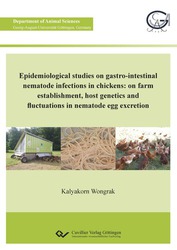| Departments | |
|---|---|
| Book Series (96) |
1378
|
| Nachhaltigkeit |
3
|
| Gesundheitswesen |
1
|
| Humanities |
2364
|
| Natural Sciences |
5406
|
| Mathematics | 229 |
| Informatics | 319 |
| Physics | 980 |
| Chemistry | 1363 |
| Geosciences | 131 |
| Human medicine | 243 |
| Stomatology | 10 |
| Veterinary medicine | 108 |
| Pharmacy | 147 |
| Biology | 835 |
| Biochemistry, molecular biology, gene technology | 121 |
| Biophysics | 25 |
| Domestic and nutritional science | 45 |
| Agricultural science | 1004 |
| Forest science | 201 |
| Horticultural science | 20 |
| Environmental research, ecology and landscape conservation | 148 |
| Engineering |
1793
|
| Common |
98
|
|
Leitlinien Unfallchirurgie
5. Auflage bestellen |
|
Advanced Search
Epidemiological studies on gastro-intestinal nematode infections in chickens (English shop)
On farm establishment, host genetics and fluctuations in nematode egg excretion
Kalyakorn Wongrak (Author)Preview
Table of Contents, PDF (61 KB)
Extract, PDF (330 KB)
The study results indicated a high prevalence (>99%) of nematode infections with the most prevalent species beingthe caecal worm Heterakis gallinarum (98.5%), followed by the roundworm Ascaridiagalli(96.2%) and the hairworms Capillaria spp. (86.1%). Capillaria spp. were composed of C. obsignata, C. caudinflataand C. bursata. It can be concluded that chickens kept in free-range systems are exposed to a higher risk of nematode infections, even if the animals are kept in a rotational system and/or in small herd sizes. However, no obvious link between high mortality rates and nematode infections could be determined. The high genetic correlation between counts of closely related worm species (e.g., A. galliand H. gallinarum) may indicate the existence of similar/same genetically determined mechanism(s) for controlling these nematodesin chickens. High heritabilities for total worm burden suggest that it is feasible to select hens for nematode resistance. Nematode egg excretion in both naturally occurring and experimental infections follows repeatable diurnal fluctuations which may indicate adaptive strategies of the nematodes to both internal and external environmental factors. Since the analytic sensitivity of egg counts suffers from low faecal egg concentrations, results from the present study suggests that faeces samples taken during daytime hours have a higher diagnostic value.
| ISBN-13 (Hard Copy) | 9783954048182 |
| ISBN-13 (eBook) | 9783736948181 |
| Language | English |
| Page Number | 120 |
| Lamination of Cover | glossy |
| Edition | 1. Aufl. |
| Publication Place | Göttingen |
| Place of Dissertation | Göttingen |
| Publication Date | 2014-09-29 |
| General Categorization | Dissertation |
| Departments |
Agricultural science
Forest science |
| Keywords | poultry, free-range, mobile stall, nematode infections, mortality rate, parasitology, genetics, egg excretion, faecal collection, natural and experimental infections, Kalyakorn Wongrak |








